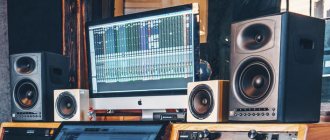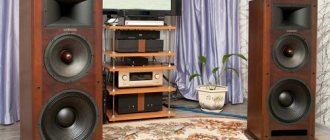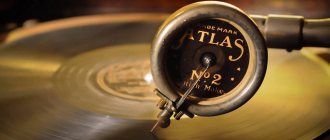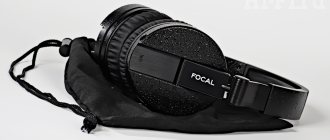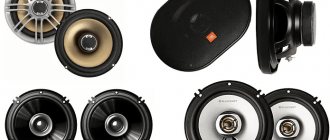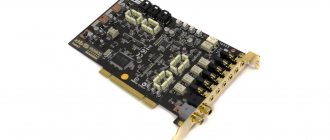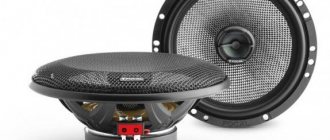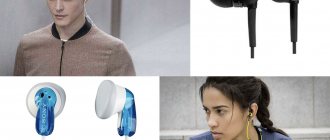There are so many acoustic systems: there are compact ones for computers, portable wireless speakers, powerful cinemas, there are models with the Hi-Fi status badge, and then there are monitors. How do they differ from regular speakers, is there any difference at all, and is it worth paying a lot of money for them? The article is just about this. It tells:
- what are studio monitors and what are they for?
- How do they differ from hi-fi devices?
The article also gives tips that will help you choose the option for your intended purpose and not be disappointed.
What are studio monitors and what are they used for?
Studio monitors are not mega-powerful sets. Their main advantage is not this at all, but their perfectly balanced frequency response. Such indicators are necessary for creating, not listening to tracks. Simply put, they are used in recording studios. This is how monitors differ from regular speakers.
Note : Yamaha, Klipsch and other advanced brands make decent monitors.
Why do you need studio monitors?
With the development of technology, home project studios, in which a preliminary idea for a track is recorded before falling into the hands of professionals, are no longer a rarity. The technical characteristics of the monitors allow you to control the balance of all composition instruments at home.
Might be useful: TOP 10 most popular portable speakers
This is the only way to achieve the desired result when mixing recorded tracks into one independent audio file. To control sound quality during recording of “live” studio sessions, monitor acoustics are also required.
Note : a good example of not too expensive, but high-quality hi-fi studios is the JBL Studio Monitor 4365. This two-channel passive system produces 300 W of sound, and its detail is excellent.
Only professional monitor systems make it possible to hear the “honest” sound of the working material. They are aimed at working in the studio and help the sound engineer find mistakes made by musicians during recording. With their help, you can hear the frequency/volume imbalance when creating a mix. Choosing monitors based solely on the “beauty” of sound is the wrong position. However, such acoustics can also be used simply to listen to music.
Interesting : “studio monitor” does not necessarily mean speakers. This can be a video monitor on which the quality of the picture (or image together with sound) is monitored during studio video editing.
Subwoofer calibration
Subwoofers must be calibrated very carefully. Use bass sweeps to find the optimal crossover frequency, which is usually between 60 and 80 hertz.
Bass sweeps are tones with frequencies from 200 to 25 hertz and the same level throughout their entire range. Pay attention to resonances around the crossover frequency. Now listen to these sweeps only on the subwoofer, turn off the speakers.
Subwoofer placement has a big impact on standing waves and room resonances. In this regard, placing the subwoofer in a corner is highly undesirable. Also, don't place it next to a wall. There is a high probability of achieving a uniform sound if it is in a free position.
In a room with parallel walls, imaginary division of the floor into 16 squares will help you find the ideal subwoofer position. Divide the length and width of the room by 4 and imagine lines on the floor or even make temporary markings using duct tape. Now you can see on which lines the subwoofer, even if it stands freely, can cause unnecessary room resonances. Therefore, do not place it on any of the lines, especially at the intersection points.
If you find a position where at the listening point the bass sweeps will sound the same on the subwoofer, then proceed to adjust the phase position between it and the monitors. Play a bass tone close to the crossover frequency by turning on the speakers and start turning the subwoofer's phase. The phase position in which the bass sounds loudest at the listening point is the most correct. Now turn on your favorite music, put on an album that is perfectly mastered. Set the volume to 85 dB SPL and raise the subwoofer level to where you feel the bass sounds just right. Your monitors should sound balanced in the bass range at 85 dB SPL.
In the chapter on listening strategy, you will learn about these 85 decibels in detail.
If you are not satisfied with the result, systematically take measurements using a measuring microphone and measuring equipment to find the ideal position of your subwoofer and adjust your monitors.
As always, there are several options. As an example, I will give the simplest option.
Firstly. Temporarily place the subwoofer in the listening position.
Secondly. Put on some bass-heavy music and walk around the room. Find where the bass sounds best in the half of the room where the speakers are located, according to the rules that will be covered in the next chapter.
Third. Install a subwoofer there.
Fourthly. Check the subwoofer phase position. Send the monitors and subwoofer a low-frequency signal equal to the crossover frequency, such as 60, 80, or 100 hertz, and move the subwoofer's phase knob back and forth. The correct position will be the one in which the bass at the listening point sounds loudest.
Fifthly. Play pink noise on your monitors and subwoofer. Place a measuring microphone at the listening point, with the tip pointing upward, and send the signal to a good spectrum analyzer.
Now you can calibrate the crossover level and frequency until the analyzer begins to show the most linear frequency response possible.
Hi-Fi acoustics
For a long time, such speakers were considered a device close to the reference sound. Audio equipment in this category is still popular among audiophiles, because Hi-Fi is a worthy alternative to music centers, and gives them a head start. As such, it is quite difficult to identify the disadvantages and advantages of Hi-Fi and monitor devices, because everything depends on the intended purpose of the equipment and personal requirements.
On topic: TOP 10 most popular stereo speaker systems
The cost of studio monitors is higher than the price of a Hi-Fi class system, but many monitor models are active, i.e. no additional amplification is required, and this can save quite a lot.
The main nuance is that Hi-Fi-level acoustics, especially if it is equipped with an appropriate amplifier, can smooth out defects in audio files, compensate for recording quality, etc., allowing the listener to get the most comfortable sound. Monitors are universal in terms of choosing a musical direction, and this is their absolute advantage. The level of detail, frequency balance and other parameters are also excellent. But the slightest flaws in the mix immediately come to light, which is useful for professionals working in the studio, but is completely unnecessary for most music lovers.
Cool and wireless: Review of the Sony SRS-XB31 portable speaker
Speaker layout
Standard
This illustration shows the installation of a Surround system for DVD audio and SA CD, according to ITU 775 standard. If you are installing a stereo system, then you should keep in mind that the placement of the front speakers should remain the same. When you install monitors in the studio, sketch out an angle of 60 degrees on graph paper, i.e. 30+30 degrees.
You can determine the optimal distance from your listening position based on the distance between the left and right speakers. Or vice versa, find the gap between the speakers based on the distance between the listening position and the speakers.
The Twitter should be at a height of 120 cm from the floor, i.e. opposite the ears of a sitting person. If the mastering engineer is tall, then of course you need to install the speakers higher.
A characteristic feature of a mastering studio is the fact that the speakers are usually positioned as freely as possible. The style of modern living rooms is largely borrowed. Not because it looks fancy or stylish, but because free-standing speakers have better playback quality. Large tables and mixing consoles create a comb filter effect and significantly degrade speaker performance by mixing direct sound with reflections.
For example, in Bob Katz's studio you won't find a regular desk. Instead, he placed a small table on wheels in the middle of the room opposite the sofa, on which the most necessary equipment is located.
I, in turn, made the following compromise: I installed a table approximately 90 centimeters wide. This is a fairly small reflective surface. This table accommodates the most essential instruments and flat LCD monitors. This allows me to make very precise settings while sitting in the sweet spot.
The comb filter effect appears when it is straight, i.e. the original signal is mixed with its copies reflected from the surface. It's no wonder this acoustic phenomenon appears so often. Anyone who rode a bicycle at night, which is equipped with a generator, passing by courtyards and fences, knows what I’m talking about. This effect changes with each change in reflection and as a result the sound of the source itself is distorted.
If you really want to experience the comb filter effect, ask your colleague to wave any flat object in front of you and to the side of you under their nose while you listen to music. These movements will cause phase effects that change the sound very noticeably. They appear due to a short delay in the reflection of sound from the direct one. These two portions are then mixed in the ear and, depending on the distance, cause some frequencies to be strengthened and others to be weakened. This can be very visually represented using pink noise generated in Wave Lab.
Copy the track and play with its delay relative to the original. Use the audio editing capabilities of Wave Lab.
On the spectral analyzer we see gaps characteristic of a comb filter.
Speaker stands must be very heavy to absorb the noise generated by the structure. Or mount speakers on spikes to provide mechanical isolation from vibration-prone surfaces. Ideally, you should do both. In this case, the speakers are protected from resonance, both of the housing itself and of the stands, which appears due to vibrations. A large speaker mounted on a very light wooden stand will cause it to vibrate and produce very unpleasant bass sounds. The spikes have a very small supporting surface area. It will be very difficult for such a surface to transmit long waves, and therefore low frequencies.
To make the stands heavier, you can fill them with quartz sand. A larger mass will require more energy to begin to vibrate. Quartz sand can be purchased cheaper at DIY stores.
Speaker directionality
It should be understood that the speakers should not be placed too close to the wall or to the corners, because The bass spreads out in circles, and the highs are very directional and linear. In the low-frequency range, interference and frequency cancellation appear. Indirect sound reflected from the wall, depending on its structure and distance from it, can be mixed with direct sound with a “+” or “–” sign, and a comb filter effect appears.
The bass produced by a subwoofer that is positioned in a corner can be perceived as 18 decibels more than the free position. Keep in mind that sound-absorbing foam will not change these characteristics because it does not absorb low frequencies.
Some speaker manufacturers make strict recommendations for optimal speaker placement.
Sweet spot
The sweet spot is the ideal listening space. In this place there is a virtual, or in other words, a phantom center. At this listening point, mono signals such as vocals or snare drums are heard between the speakers and are strictly centered. The direction of the tweeters also plays a role in the size of the sweet spot.
In order to get an idea of its size, move in front of the speakers from left to right and back and forth, paying attention to the proportionality of the high frequencies in the music that is currently playing. Once you hear less highs or feel that the lead vocal is no longer coming from the phantom center, you are outside the sweet spot.
Should I use headphones?
Good headphones, a quality preamp and appropriate psycho-acoustic processing will be a very useful addition to good monitors. But, in no case, not as a replacement.
Headphones will serve as a good alternative for the final check and will help you easily detect artifacts.
I recommend the BAP-1000 psycho-acoustic treatment from AKG. This device has now been discontinued, but is still sold at an affordable price. BAP-1000 calculates the acoustic characteristics of 9 legendary studios, after which it determines the spatial location of the signal.
If you sit in front of your monitors and the signal comes only from the left speaker, the direct sound reaches only the left ear. Due to the size and shape of the head, certain frequencies are delayed and therefore reach the right ear a little later, in addition, their level is already significantly lower. But in the case of headphones, the signal can be heard in this case only in the left ear.
Everyone knows the unnatural feeling of music inside your head when you listen to it on headphones. A psycho-acoustic preamp adds natural spatial information that is lost in this way. Hence, with its help, you will be able to experience natural spatial perception through headphones. As with monitors, the more you know your headphones, the better.
What to choose?
When choosing acoustics, it is important to consider only three things:
- technical characteristics - both the Hi-Fi device and the monitor models are excellent;
- personal preferences, as well as hearing characteristics (you will have to listen to the systems “live”);
- the role that the system will play: whether it will be used for film sound recording or is it needed for professional work.
| Acoustic type | What is it suitable for? |
| Regular - home - acoustic set / music center | If music is just a background that is needed for the atmosphere during relaxation, work, everyday activities, etc. In addition, this choice will allow you to save significantly: even floor-standing wireless speakers like the F&D T-60X can be much cheaper than a hi-fi device. |
| Hi-Fi systems | This is the choice of those for whom not only volume is important in music, but also rich, superbly balanced frequencies that allow you to enjoy all the colors of the composition. The sound detail here is at its best, so speakers like these, for example, the DALI Zensor 1, are suitable for picky music lovers. |
| Studio monitors | The optimal solution for people whose goal is to create a musical product, not at the level of a self-taught amateur, but no worse than a professional in world-famous studios. Simply put, if the material is created for further publication on labels, radio stations and for other commercial purposes, then there is no need for monitors, even if after preliminary production the material is sent for revision to a professional studio. By the way, a fairly popular company that creates monitor devices is JBL. |
Educational program: Two-way and three-way speakers - what's the difference: 3 types of speakers in acoustics
For those who just want to increase the volume or buy acoustics for entertainment: watching movies, parties with karaoke and music, just a good stereo system or home theater is enough. Users who are more demanding in terms of sound should take a closer look at Hi-Fi models: breathtaking detail and “leveling” of frequency balance allow you to hear each instrument and enjoy its sound. To create your own compositions, you need studio monitors: even the slightest imperfections will definitely be heard in them, and this will help achieve the perfect sound.
Near field monitors.
The world's first near-field studio monitor standard was formed by the Yamaha NS-10. Start of production 1981
Yamaha NS-10m
Before the Yamaha NS-10, short-range monitoring was built from the series of “who can do what.” The Yamaha NS-10 and its modification, the Yamaha NS-10M, have de facto become a kind of standard and benchmark for sound engineers around the world.
Let's see how they are made.
Volume 10.4 l. LF 180mm driver with lightweight paper cone. HF 35mm driver (with a larger diaphragm than is common in hi-fi). Crossover two-way, second order, passive; Frequency range 60 Hz to 20 kHz; sensitivity 90 dB. Head crossover frequency 1.5 kHz ; Impedance 8 ohms.
Filters-Yamaha-NS-10M
Initially, the Yamaha NS-10 was conceived as household hi-fi speaker systems. But they were not successful as household speakers. They were met with hostility by the international hi-fi press and audiophiles.
However, the Yamaha NS-10s have been enthusiastically accepted by most recording studios as nearfield monitors. After which they were modified to increase the overload capacity, which was not enough. The letter M was added, and they became Yamaha NS-10M.
If you type the query “recording studio” in Yandex, in about a quarter of the pictures you will see Yamaha NS-10M monitors. Moreover, these can be ultra-modern and very sophisticated studios. We remind you that 40 years have passed since the release of the NS-10.
Yamaha NS-10M monitors in the studio
Power Station Studio at BerkleeNYC. The mixer has Yamaha NS10M monitors.
You should not think that these monitors are incredibly wonderful, and for this reason they turned out to be so in demand. The situation was most accurately described by one of my acquaintances, a musician who started producing content: “all the soundtracks sound crap, but understandable, and equally crap.”
And they are poorly made. They filled the seal to capacity, which is not good. I won’t say anything about filters, but everything is clear.
The level of cult status of the Yamaha NS-10 is evidenced by the fact that even now, many decades later, their clones are being industrially produced.
Avantone CLA-10 Passive Studio Monitor
A clear and obvious difference between the Yamaha NS-10 and household acoustics. Speaker crossover frequency – 1.5 kHz . And this was in 1981!!! Speakers in two-way household acoustics do not divide so low even now.
You can read more about the circuits for dividing speaker heads, and what the result is, here .
It is quite understandable that they were met with hostility. Listening to music on two-way speakers with such a low crossover frequency is absolutely not comfortable.
The problem is not the speaker pairing frequency. Filters rotate the phase by 180 degrees. Accordingly, at a frequency of 1.5 kHz the phase is reversed. If at 1.5 kHz the bass/midrange speaker had a natural roll-off, then everything would be normal for listeners to perceive. We will return to this issue in the last chapter of the article - far-field monitors.
The success of these monitors was not a smooth frequency response.
I can assume that the Yamaha NS-10 was the first two-way acoustics in which they began to divide the bands so low. And this is precisely what led to success in the studios .
Yamaha NS-10M, frequency response
Explanation of individual pictures:
Rice. 6. Characteristics of the Yamaha NS-10M monitor in “free field” conditions.
Rice. 7. Characteristics of the Yamaha NS-10M monitor installed on the mixer shelf.
That is, these monitors were initially focused on monitoring the mid-high frequency range. And the lower bass register was only indicated.
At the same time, in studios they don’t pay much attention to how to install monitors. Horizontal or vertical. Usually this question is outside the discourse. The way they put it was good.
Although the difference in frequency response when the monitors are positioned horizontally or vertically, especially when the listener’s head moves, will be colossal. See the difference in frequency response from their location in the picture above.
Yes, the frequency response will be very different, but this has little effect on the quality of perception of the material and the result of mixing. Sound engineers practically know this. And those who are interested in this question can read our article - Why doesn’t the copier principle work in acoustics?
This once again means that both in the “studio” and in home audio, adequate people do not set themselves the task of bringing the frequency response to the most flat line.
To fully meet the modern standard of Yamaha NS-10 studio monitors, it was necessary to take only two steps.
Step one is the transition from passive to active division of stripes. The so-called bi-amping. When the bands are allocated by RC chains, in the low-current path in front of a separate amplifier for each speaker. And there are no passive filters in the path (between the speakers and amplifiers).
To the ear, active filters “sound” completely different from passive ones. It’s not just a matter of intelligibility; the sound “character” of active and passive filters is completely different to the ear. Although the decay graphs of the bands, their frequency response may be absolutely similar. In most cases, this is due to the fact that with passive filtering, different speakers can be put into different control modes and matching with the amplifier. For those interested, more details on this issue can be found here:
- “Character of the sound. Selecting the type of mixing of household speakers.
- Purpose of audio capacitors in the acoustics path.
Using active filters allows you to limit yourself to almost nothing..
In passive filtering, of course, you can accumulate something like 3-4 orders of magnitude. But the level of nonlinearity obtained, and as a consequence of the final quality of these filters, will be indecent . It is impossible to get a good result.
In active filtering there are no nonlinearities. More precisely, the distortions are at the microscopic level. Compared to passive filters, they have no distortion. And the orders of filters can be set essentially endlessly:
Typical filter circuit for studio monitors. (the value of the HF capacitor is incorrect)
Speakers in studio monitors are divided extremely low and very harshly.
Thus, everything they are capable of is squeezed out of the speakers to the maximum.
And this is very logical! If Twitter reproduces high frequencies well, then let it reproduce only these high frequencies. And it is not overloaded with mid frequencies.
If in the household Hi-End they are touched by the sound of the first order at high frequencies, simultaneously loading the tweeter with a couple more octaves from below... Then in monitor systems they are not touched by anything. The tweeter is allowed to “play” only the tweeter, rigidly cutting out its band. Exactly what he knows how to do well and what he is intended for.
The LF/MF link is dealt with in the same way. He is allowed to “play” only that frequency range that he “plays” remarkably well. It is precisely from the rigid selection of stripes that the final legibility is excellent. And the power (output) of the tweeter can be increased four times!!! (since it is not overloaded with those frequencies that it does not “play”).
An ordinary person, encountering the sound of high-quality monitor systems for the first time, immediately notices how much higher the sound pressure they create without overloading. Compared to household acoustics of the same dimensions.
And here the last step is taken, which forms the currently unified standard for studio monitors.
As noted earlier, in the high-current acoustics path (between the amplifier and speakers), coils with enameled wire and other “garbage” with its wild nonlinearities have disappeared. Coupled with the possibility of hard lane selection, this opens up new possibilities. A speaker reproducing low/mid frequencies can be and becomes :
- With a heavier moving system
- With stiffer suspension (less equivalent volume)
What happens is what can conventionally be called “ subwooferization ”. Thus, rigid and very heavy cones for subwoofer speakers became possible only when the possibility of active filtering for them became possible.
Example. With passive filtration, it is impossible to obtain at least some adequate result with a low-frequency head with the following parameters: 10 inches, VAS 30 liters, moving mass 200g. But with active filtering, quite a decent result can be obtained if you strictly limit the range of reproduced frequencies of this speaker to 150Hz.
The same applies to studio monitors. The mass of the moving system is doubled, and VAS is reduced by 2-3 times (from values typical for Hi-Fi). This is very clearly visible if you look inside the studio monitors. Compared to household speakers, they have almost no volume.
Studio monitors inside
And of course, no paper diffusers for the bass/midrange are now required - for the frequency band they reproduce, almost anything will do... plastic, Kevlar, etc.
For audio monitoring purposes, plastic diffusers are even better - they give an almost ideal, even frequency response in the frequency band used. Since plastic, unlike paper, is a homogeneous substance. And plastic has practically no local frequency response emissions.
And the result is exactly what is needed for audio monitoring: compactness, high overload capacity, resolution.
But there is only one drawback. Severe phase distortion. Everyone who works with audio monitoring knows and understands this specificity very well. It is the same for all studio monitors, and is learned by everyone.
It is approximately clear how the finished material will sound on broadband acoustics, on which the vast majority of people actually listen to music. And to control the presence of errors, any studio has one or another version of wideband acoustics. They also make wideband studio monitors (near field). They are not for information, but specifically for understanding the overall picture, otherwise you can fly away very much.
Wideband studio monitors
Three-way acoustics are never used in studio practice for mixing and mastering . If you heavily filter the bands of a three-way speaker, the phase distortion will reach a level where you completely lose track of where everything is.
Three-way speakers are truly being placed in the far field of recording studios. But not for mixing and mastering. And in order to understand the overall picture, tonal balance and bass level. But they put her in the outfield.
And all mastering is always done in the very near field. And always on two-way speakers.
And the musicians themselves should somehow listen to what they played there. And if there are 10-15 people, together with producers and friends, then that’s not a lot. So they listen to far-field monitors. And only one person can fit in the near field.
Features of choice
Based on their design features, such devices are divided into two types: active and passive. The first will differ from the second by the presence of a built-in amplifier. If you plan to purchase only passive elements, then you should additionally purchase a high-quality amplifier. There are plenty of admirers of both passive and active installations. It is impossible to determine with certainty which design is better. Passive ones do not have any unnecessary elements. Active ones are more expensive, but amplifiers are included with them, which makes the sound quality of the selected model as suitable as possible.
It should also be noted that studio settings differ in the degree of action: long, medium and near. A distinctive feature will be the dimensions of the selected devices.
To set up a home studio, you should take into account the square footage of the selected room. In small rooms, it is recommended to install models up to 8 inches (short range). It would also be a good idea to take care of high-quality sound insulation.
| pros | Minuses | |
| Active | 1. Does not burn out over time, since the circuitry used undergoes serious testing. 2. Fine adjustment option, which will allow you to set the necessary parameters based on the characteristics of the room used. 3. The amplifier is included. 4. Abundance of analog and digital inputs. 5. Scope of application. | 1. The sound engineer will not be able to control the volume from the workplace. 2. Difficulty of subsequent repairs. 3. Abundance of wires. |
| Passive | 1. Hardware volume control. 2. Thoughtful acoustic space. 3. Quickly find the breakdown and its further elimination. 4. There are no unnecessary elements. 5. Equipped with signal wire only. 6. Easy to install. | 1. Immobility after installation. 2. Only line and acoustic input are provided. 3. A reinforced type auxiliary path will be required. |
Rating of the best inexpensive models
Axelvox PM – 5 A
Belongs to the category of studio monitors of the new series. Corner models that belong to the budget price segment. Unlike most products on the market, this set comes in pairs. It is recommended to use when setting up a small recording studio due to the compact dimensions of the installation. The developers were particularly successful in maximizing sound frequencies and detailing the high and mid ranges by adapting the mid/bass drivers. Evenness in the applied ranges can be achieved by setting the frequency response parameters. The designs cope with the assigned tasks, namely working with high frequencies, excellently. There is an option to separate filters. The weight of the set is 11 kg.
The average price is 12,570 rubles.
Axelvox PM – 5 A
Advantages:
- 75 W;
- price;
- dimensions;
- opportunity to set up a small studio.
Flaws:
- The bass can hardly be called flawless.
KRK ROKIT 5 G3
An easy-to-use and inexpensive device, which is considered a popular product from the renowned manufacturer KRK. Two-way design for near-field power of 50 W. The slot bass reflex has undergone significant changes. Guarantees improved transmission of low frequencies. The maximum SPL has undergone B and A class updates. Produces 106 dB and operates in the range of 45-36 thousand Hz. The Bi-amping option, which is responsible for amplifying and separating the upper and lower ranges, deserves special attention. High-quality MDF is used to make the case. The weight of the set is 5.9 kg, with dimensions 18.8x28.4x24.6 cm.
Price – 13,200 rubles.
KRK ROKIT 5 G3
Advantages:
- design;
- shielding;
- auto shutdown;
- wide range;
- clean mids and tops;
- assembly.
Flaws:
- Factory defects are not uncommon.
Pioneer S-DJ50X
Popular model from the legendary manufacturer. The build quality is felt, even though the design belongs to the middle price segment. Recommended for arranging the office of producers and DJs. The set produces 80 watts. Element dimensions are 1 inch (HF) and 5 inches (LF). A characteristic feature is the presence of convex type diffusers and a soft dome. It should be noted that the manufacturer has successfully integrated DECO technology, which was previously observed only in top models. It has become easier to control the high frequencies due to the spatial direction of the diffusers.
The membranes contain reinforced fiber, which has a beneficial effect on the characteristics of the front low-frequency reflection system. Regardless of the volume setting, the playback quality will be amazing. The port for the bass reflex is located on the front side of the case. Only standard connectors are used. The system will automatically enter standby mode after 25 minutes of complete inactivity. The weight of the set will be 6.5 kg, with dimensions of 19.7x30.1x26.2 cm.
Price – 14,500 rubles.
Pioneer S-DJ50X
Advantages:
- auto shutdown option;
- high-quality bass;
- sound;
- top manufacturer.
Flaws:
- There is no possibility of adjusting the bass.
Behringer Truth B 2031 A
Products from a German manufacturer are famous for their quality and functionality. Bass reflex active monitor of two-way type. High-quality materials are used in manufacturing: Kevlar is used for the woofer with a membrane, the chassis is made of aluminum cast under high pressure. High resolution two-inch ribbon emitter. Availability of a double amplification system to increase the power indicator. To achieve the most even AFC, the manufacturer carries out manual correction during the assembly process. A measurement protocol is attached to each specimen.
Monitor with a nominal power of 140 W, maximum – 265 W. Possible sound pressure level is 116 dB SPL. Bass and treble are supported separately. Magnetic protection is present. Product weight – 15 kg with parameters 25*40*29 cm.
The average price is 16,264 rubles.
Behringer Truth B 2031 A
Advantages:
- separation filters for manual sound adjustments are conveniently placed;
- excellent detailing of subtle shades;
- Kevlar membrane;
- price-quality ratio.
Flaws:
- The auto shutdown threshold is too high.
Installation and positioning
It is very important not only to choose good monitors, but also to be able to position them correctly - there are many pitfalls in this that beginners stumble upon. Choosing a point for the monitor so that the listener gets the right sound without distortion can be difficult. In general, the use of mid-field monitors (more on them below) in large studios and control rooms implies appropriate acoustic design of the room.
Reflections from walls and other surfaces can interfere with the mixing process, but this is not as critical when using near-field monitors where the listener is too close to the sound source. However, both near-field and mid-field monitors can suffer from sound reflection coming from the sides. This reflection will cause changes in the frequency range and will not have the best effect on the overall sound. To avoid such problems, you should reconsider the location of monitors in the room. It may also make sense to think about the acoustic design of surfaces. It is worth saying that the slightest movement of the sound source can greatly affect its perception.
Of course, it is unlikely that you will be able to arrange the monitors correctly the first time, devoting only a few minutes to this process. This will require a few checks to find the best position for the monitor. For those who do not fully rely on their own hearing, there are special systems consisting of software, measuring microphones and special ADCs that will allow you to adjust the output signal to a specific room.
Sometimes, for good sound, you need to edit not only the angle of the monitor, but also the height at which it is located. Ideally, the tweeter should be located at ear level and slightly tilted, so that the monitor is completely directed towards the listener. It is also worth paying attention to the installation of monitors, as well as the structures used for their installation. There are racks and stands made of special materials, they are designed to suppress unnecessary vibrations.

